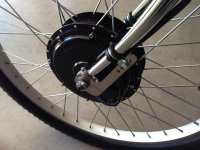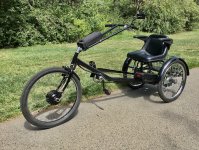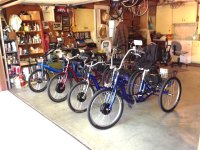First ebike 14 years ago. Day 6/Bionx RWD, nice ride, decided to build my own RWD (never seen a Harley with FWD) and built 3 bikes with RWD. Balance sucked (lead era) and issues with everything else on the rear wheel were fussy. My butt also!
Accidentally ran into a guy that had a 26" FWD hanging in his garage which he bad mouthed as wrong thinking and gave it to me. Put it on a free bike (Schwinn Jaguar step thru) which helped the balance. Noticed that there is a difference between being pushed by RWD and pulled by FWD. Prefer being pulled after gaining experience. Went on to build several more FWDs. RANS V2 recumbent with FWD is an incredibly nice ride and FWD has been beyond perfect. As my kid says "awesome!"
Then I Thought about tricycles, what I call pickup trucks. Chalo calls "granny trikes" for me "Geezer Glider" 'cause I'm a guy - I think. Put FWD on 23 Schwinn Meridian 26" Trikes and a couple of 24" Gomiers. Sold them on Craigs list and have kept 3 for my personal use.
Torque arms are not an issue with the Meridian. I have steel forks, strong dished drop outs, and C washers. Never had an issue and have stopped using TAs except on one trike that I have two TAs, hot rodder by nature.
View attachment 349698View attachment 349699View attachment 349700Started with Day-




